|
|
|
Air of Authority - A History of RAF Organisation
Badges, Standards and Battle Honours
[Badges | Standards | Battle Honours | Other Heraldry | Drum Markings]
From its early days units of the RAF adopted badges and emblems to display on their aircraft in order to provide a means of identifying them from other units. Fighter units took this a stage further and in the 1920s were allowed to adopt official identification markings on the wings and fuselages of their aircraft but these were not badges. In March 1935, it was decided to standardise on the format of the badge design with the College of Heralds and the Air Ministry appointing the Chester Herald as the first Inspector of RAF Badges. The first tasks were to design a standard frame for the badges and determine the qualifications needed before a unit could apply for its own badge. The frame adopted is shown below (left),
The qualifications decided upon were:
The unit should have been in existence for at least two years and was likely to remain in existence
The unit should have a status and function which can justify the sanction of a badge (but exactly what these were was not clarified)
Each unit would decide on the emblem or device to place in the central portion of the badge and on what motto they wished to place in the scroll at the base of the badge, which would then be submitted to Inspector of RAF Badges, together with the reasons for the choice and a fee. The Inspector would then check that the design met heraldic standards or adapt it, if necessary, before passing it to the Chief of the Air Staff for approval, who in turn would submit it to the Monarch for final authorisation. Once approved, but not before, the badge could be applied to the unit's correspondence, equipment and aircraft.
Units which fail to meet the requirements laid down above can adopt a badge based on that of their higher controlling formation, examples include the badge of RAF Cowden, a weapons range in Yorkshire and RAF HQ Units at USAF bases in the UK, which used the Strike Command and Support Command badges respectively.
The policy referred to above was formally announced in AMO A14/36 of 16 January 1936.
A unit badge maybe placed on aircraft and other RAF property provided it has been accepted for registration by the inspector of Royal Air Force badges and the Chief of the Air Staff and approved by His Majesty The King.
(i) The position for placing unit badges on aircraft will be, whenever possible as under: -
Single-engined tractor -On each side and in the centre of the fin. The height of the distinctive shape is not to exceed eighteen inches.
Multi-engined tractor - On each side of the fuselage or, in the case of flying boats, the hull, beneath and (when possible) slightly in rear of the pilot's seat. The height of the distinctive shape is be twenty-four inches,
Blenheim aircraft - as for single-engined tractor type*
(ii) The unit badge on mechanical transport will be placed at the front end of the body. The height of the distinctive shape is to be twelve inches.
(iii) In the case of units which have ready placed their approved badge on aircraft or mechanical transport no change need be made until new aircraft are taken into use, or until vehicles are repainted.
Where serial numbers or W/T markings upon aeroplanes encroach upon space required for the unit badge they are to be transferred to any convenient part of the component. AID markings are not to be removed or defaced but are to be covered by fabric
Units at present using a badge, and wishing to continue doing so, should forward a specimen to the Inspector of Royal Air Force badges (see para 8) who will consider its suitability for registration under the terms of this order. A brief statement giving the origin of, and reasons for adopting, the badge should be forwarded when known.
In the event of a badge not conforming with the terms of the Order or being considered unsuitable for registration, the Inspector of Royal Air Force badges will advise the unit regarding any minor modifications which would render it acceptable or as to the necessity for a flew design.
The design of new badges and the modification of those now in use will be carried out by the Inspector of Royal Air Force badges indirect communication with the units concerned. He will consult with the Air Historian as may be necessary and submit the design to the Air for approval before registration.
The standard frame for badges is as under and may be used with or without the scroll at the foot for the motto :-
|
|
|
The individual badge of the unit will form the centre piece of the standard frame but will not be used separately on RAF property except as stated in para 6. NB The design originally utilised the Tudor Crown (commonly referred to as King's Crown), as shown above, but this was replaced on 11 November 1954 by St Edwards Crown (commonly referred to as the Queen's Crown), and reverted to the Tuder Crown on the accession of King Charles III |
Operational units are authorised to use their individual badge without squadron number or other inscription. In order that the badge can be easily distinguished on aircraft or other RAF property, a white background of distinctive shape, suitably outlined in the major colour of the badge and indicating the principal operational function of the unit, has been approved its under -
 |
 |
 |
| Fighting | Bombing | Reconnaissance |
| Fighter | Bomber Torpedo Bomber Bomber Transport |
General Reconnaissance Army Co-operation Flying Boat |
In order to cover the incidental expenses involved, units wishing to register badges will be required to pay to the inspector of Royal Air Force badges the sum of ten guineas from non-Public funds. This payment will cover :-
Correspondence and postage.
Design of badge.
Registration.
Copy in colour of the registered design for the unit.
Photostat copies of the design for Air Ministry records.
Official registration record to be kept by the Inspector of Royal Air Force badges.
The name and address of the Inspect6r of Royal Air Force badges are: -
J. P.
Heaton-Armstrong, Esq,
Chester Herald,
College of Arms
Queen Victoria Street,
London, EC
KR & ACI, para. 796, clause 2, will be amended in due course.
A description of each unit badge and the unit motto, after approval by His Majesty, will be placed in the Air Force List immediately below the title of the unit.
This order does not apply to units of the Fleet Air Arm which is provided for as laid down in Admiralty Fleet Order No 1205, dated 14th May, 1936.
Amended by AMO A150/36 dated 25 June 1936 and AMO A302/36 dated 10 December 1936
Amended by AMO A24/37 - Standard Position for Unit Badges on Aircraft and Mechanical Transport dated 28 January 1937 and AMO A86/37 dated 1 April 1937.
*Amended by AMO 136/38 dated 14 Apr 1938
The first batch of badges authorised was announced as shown in Air Ministry Order A142/1936 dated 18 June 1936, below: -
Unit Badges
His Majesty The King has graciously approved the use of the
under mentioned badges and mottoes by the following units, and they may now be
taken into use as laid down in AMO A.14136.
| Unit | Badge | Motto |
| No 4 (Army Co-operation) Squadron | A sun in splendour divided per bend by a flash of lightning. | In Futurum Videre |
| No 15 (Bomber) Squadron | A Hind's head affrontee erased at the neck between wings elevated and conjoined in base | Aim Sure |
| No 18 (Bomber) Squadron | A Pagasus rampant | Animo et Fide |
| No 22 (Torpedo-Bomber) Squadron | On a torteau, a Maltese Cross throughout, over all a "π" fimbriated | Preux et Audacieux |
| No 33 (Bomber) Squadron | A Stag's head affrontee couped at the neck. | Loyalty |
| No 201 (Flying Boat) Squadron | A Seagull, wings elevated and addorsed. | Hie et ubique |
| No 207 (Bomber) Squadron | A winged Lion statant | Semper Paratus |
| No 604 (County of Middlesex) (Fighter) Squadron | A seax | Si vis pacem para bellum |
Air Ministry Order A159/1936 dated 2 July 1936 added: -
| Unit | Badge | Motto |
| No 2 (Army Co-operation) Squadron | Three concentric circles over all a Wake knot | Hereward |
Air Ministry Order A186/1936 dated 6 August 1936 added: -
| Unit | Badge | Motto |
| No 1 (Fighter) Squadron | The numeral "1" winged | In Omnibus Princeps |
| No 19 (Fighter) Squadron | Between wings elevated and conjoined in base, a dolphin head down | Possunt quia Posse Videntur. |
| No 43 (Fighter) Squadron | A gamecock | Gloria Finis |
| No 55 (Bomber) Squadron | A cubit arm, the hand grasping a spear. | Nil nos Tremefacit |
| No 56 (Fighter) Squadron | A phoenix | Quid si Coelum Ruat |
| No 216 (Bomber Transport) Squadron | An eagle, wings elevated, holding in the claws a bomb | CCXVI Dona Ferens |
Air Ministry Order A256/1936 dated 29 October 1936 added: -
| Unit | Badge | Motto |
| No 17 (Fighter) Squadron | A gauntlet | Excellere Contende |
| No 25 (Fighter) Squadron | On a gauntlet a hawk rising affrontee | Feriens Tego |
| No 27 (Bomber) Squadron | An elephant | Quam Celerrime ad Astra. |
| No 28 (Army Co-operation) Squadron. | In front of a demi pegasis a fasces | Quiequid Agas Age |
| No 35 (Bomber) Squadron | A horse's head winged | Uno Animo Agimus |
| No 39 (Bomber) Squadron | A winged bomb | Die Noctuque |
| No 45 (Bomber) Squadron | A winged camel | Per Ardua Surgo |
| No 70 (Bomber Transport) Squadron | A demi winged lion erased | Usquam |
| No 111 (Fighter) Squadron | In front of two swords in satire a cross potent quadrat charged with three seaxes fesswise in pale. | Adstantes |
| No 601 (County of London) (Fighter) Squadron | A winged sword | - |
| No 610 (County of Chester) (Bomber) Squadron | A garb | Alifero tollitur axe ceres |
| No 6 Flying Training School | A hand holding a torch | Aspice et Imitare |
| No 2 Armoured Car Company | A winged wheel | Nunquam non paratus |
Air Ministry Order A293/1936 dated 3 December 1936 added: -
| Unit | Badge | Motto |
| No 9 (Bomber) Squadron | A Bat | Per Noctem Volamus |
| No 16 (Army Co-operation) Squadron | Two keys in saltire the wards upwards and outwards, | Operta Aperta. |
| No 26 (Army Co-operation) Squadron | A Springbok's head couped | N wagter in die lug |
| No 54 (Fighter) Squadron | A Lion rampant somee de Lys | Audax Omnia Perpeti. |
| No 64 (Fighter) Squadron | A Scarabee | Tenax Propositi |
| No 607 (County of Durham) (Fighter) Squadron | A winged Lion salient, the hind legs also winged. | - |
| No 611 (West Lancashire) (Bomber) Squadron | In front of a Trident a Rose | Beware Beware |
Air Ministry Order A17/1937 dated 21 January 1937 added: -
| Unit | Badge | Motto |
| No 32 (Fighter) Squadron | A hunting horn stringed | Adeste Comites |
| No 57 (Bomber) Squadron | Issuant from two logs fesswise in saltire a phoenix | Corpus non animum muto |
| No 65 (Fighter) Squadron | In front of fifteen swords in pile, the hilts in base, a lion passant. | Vi et Armis |
| No 84 (Bomber) Squadron | A scorpion | Scorpiones Pungunt |
| No 104 (Bomber) Squadron | A thunderbolt | Strike hard |
| No 2 Flying Training School | A winged torch | Verbum sat Sapienti. |
Air Ministry Order A69/1937 dated 11 March 1937 added: -
| Unit | Badge | Motto |
| No 12 (Bomber) Squadron | A fox's mask | Leads the field |
| No 40 (Bomber) Squadron | A broom | Hostem a coelo pellere |
| No 41 (Fighter) Squadron | A double-armed cross | Seek and destroy |
| No 74 (Fighter) Squadron | A tiger's face | I fear no man |
| No 203 (Flying Boat) Squadron | A winged sea horse | Occidens Oriensque |
| No 230 (Flying Boat) Squadron | In front of a palm eradicated a tiger passant guardant | Kita Chari Jauh |
| No 11 Flying Training School | Two dexter bands couped at the wrist holding a winged torch | Passim ad Astra |
| School of Air Navigation | A star of eight points | Reete Volare |
Air Ministry Order A160/1937 dated 20 May 1937 added: -
| Unit | Badge | Motto |
| No 29 (Fighter) Squadron | An eagle in flight preying on a buzzard | Celer et Audax |
| No 38 (Bomber) Squadron | A heron volant | Ante Lucem |
| No 49 (Bomber) Squadron | A greyhound courant | Cave Canem |
| No 66 (Fighter) Squadron | A rattlesnake | Cavete Praemomui |
| No 151 (Fighter) Squadron | On a hurt an owl affrontee wings elevated alighting on a seax | Foy pour devoir |
| No 269 (General Reconnaissance) Squadron | An ancient ship in full sail | Omnia Videmus |
Air Ministry Order A211/1937 dated 1 July 1937 added: -
| Unit | Badge | Motto |
| No 11 (Bomber) Squadron | Two eagles volant in pale | Ociores acrioresque aquilis |
| No 13 (Army Co-operation) Squadron | In front of a dagger a Lynx's head affrontee | Adjuvamus tuendo |
| No 14 (Bomber) Squadron | A winged plate charged with a cross throughout and surmounted by the head and shoulder pieces of a suit of armour | I spread my wings and keep my promise |
| No 20 (Army Co-operation) Squadron | In front of a rising sun an eagle wings elevated, perched on a sword | Facia non verba |
| No 23 (Fighter) Squadron | An eagle preying on a falcon | Semper aggressus |
| No 24 (Communications) Squadron | A black cock | In omnia parati |
| No 31 (Army Co-operation) Squadron | In front of a wreath of laurel a mullet | In caelum indicum primus |
| No 500 (County of Kent) (Bomber) Squadron | A horse focene | Quo fata vocent |
| No 602 (City of Glasgow) (Bomber) Squadron | In. front of a Saltire a lion | Cave leonem cruciatun |
Unit Badges
Formations and units are reminded that once a badge has been approved by His Majesty the King, it remains the badge of that formation or unit, irrespective of any changes in operational role or title.
If a unit is disbanded and is not to be immediately reformed, the original signed painting should be returned to the Inspector of RAF Badges for custody until such time as, the unit is re-formed.
Every care should be taken to ensure that paintings signed by His Majesty the King are not lost or damaged. Units wishing to do so may send the original painting to the Inspector of RAF Badges, and it is particularly recommended that units ordered abroad should follow this course.
When a unit is renamed, or given a sub title, e.g. (Punjab), (China British), but not when there is only a change in operational role, an application may be made to the Inspector of RAF Badges for a copy of the unit badge shown in the standard frame with the sub title added. Each painting will be supplied at a cost of £3 13s 6d, which is to be borne by the non-public funds of the unit concerned. It will not be submitted to His Majesty the King. The light blue of the RAF ensign will be used in the circle of the standard frame, irrespective of whether the original painting shows the "grey-blue" formerly used in the circle, and it will be dated with the month and year in which it is issued by the Inspector of RAF Badges, to whom application and payment should be made direct
The operational function of a formation or unit (other than command headquarters) in Fighter, Bomber, Coastal. Army Co-operation or overseas commands, is not to be included in the standard frame in reproductions of any kind. Such formations or units are to be described in the standard frame on stationery, etc, as in the following examples: -
Headquarters, No 1 Group.
No 1 Squadron
No 247(China-British) Squadron.
No 500 (Connty of' Kent) Squadron.
Attention is drawn to the fact that it is incorrect to reproduce the central portion of the badge, with or without the motto, except, in the standard frame. Units in any doubt as to the, form in which, they may reproduce, their badge should, communicate direct with: -
J D Heaton-Armstrong, Esq., MVO,
Chester Herald and Inspector of RAF Badges,
The College of Arms,
Queen Victoria Street,
London, EC4
Source - Air Ministry Order A899/1941 dated 30 October 1941.
Unit Badges - Procedure or Obtaining Official Recognition
A unit badge will only be officially recognised as such after it has been accepted for registration by the Inspector of RAF Badges and the Chief of the Air Staff and approved by His Majesty the King.
Units wishing to register a badge and secure approval for its use, should forward a sketch to the Inspector of RAF Badges (see para. 6 below) who will consider its suitability for registration. A brief statement, giving the origin of, and reasons for adopting the badge, should also be forwarded. *Formations and units in Maintenance Command, subject to the permission of the AOC-in-C, may apply for an individual badge and motto of their own.
In the event of a badge not being considered suitable for registration, the Inspector of RAF Badges will advise the unit direct on any modifications or changes of design which may be necessary.
The Inspector of RAF Badges will consult the Air Historian as may be necessary and submit the final design to the Air Ministry for approval, before registration.
In order to cover the incidental expenses involved, units wishing to register badges will be required to pay to the Inspector of RAF Badges the sum of fifteen guineas from non-public funds. This payment will cover -
correspondence
design of badge
registration
copy in colour of the registered design for the unit.
The name and address of the inspector of RAF Badges is: -
J D Heaton-Armstrong, Esq, MVO,
Chester
Herald,
College of Arms,
Queen Victoria Street,
London, EC
The instructions for using unit badges on aircraft and RAF property are contained in AMO A721/46.
A description of each unit badge and the unit motto, after approval by His Majesty, will be placed in the Air Force List immediately below the title of the unit.
(AMOs A14/36, A150/36, A303/36, A24/37, A86/37 and A136/38 cancelled)
Source - Air Ministry Order A720/46 dated 15 August 1946.
*This sentence was added by AMO A821/46 of 19 September 1946
Use of Unit Badges on Aircraft and RAF Property
A unit badge may be placed on aircraft and other RAF property provided it has been accepted for registration by the Inspector of RAF Badges and Chief of the Air Staff and approved by His Majesty The King.
2. The standard frame for badges is as under and may be used with or without the scroll at the foot for the motto .
|
|
|
The individual badge of the unit will form the centre piece of the standard frame but will not be used separately on RAF property except as stated in para 3 (a) (i) The operational function of squadrons will not be shown |
The regulations for placing unit badges on aircraft and MT vehicles will be as follows: -
Aircraft.
Operational units are authorised to use their individual badge without squadron number, motto or other inscription.
So that the badge may be easily distinguished on aircraft, it may be placed on a circular white background, 18 inches in diameter, with a half-inch border of RAF pale blue.
Badges may, however, be applied directly, to the aircraft without background, but the height must not exceed 18 inches.
As the positions of badges on aircraft must vary according to type, the standard position for each type will be laid down by commands, after consultation with the Air Ministry (ACAS) (Ops).
Badges will not be positioned on movable aerofoil surfaces.
Where serial numbers or WT markings on aircraft encroach upon space required for the unit badge they are to be transferred to another convenient part of the component. AID markings are not to be removed or defaced.
Where units have already placed their approved badges on aircraft, no change need be made until new aircraft are taken into use.
MT Vehicles.
The badge, including the standard frame, will not exceed 12 inches in height and will be applied directly to the vehicle without background.
The positions of badges will be standardised for each type of vehicle. The-regulations will be laid down in AP 3090 (RAF Mechanical Transport, Regulations).
Where units have already placed their approved badges on MT vehicles, no change need be made until the vehicle is changed or repainted.
The procedure for obtaining official recognition of unit badges is laid down in AMO A720/46..
Source - Air Ministry Order A721/46 dated 15 August 1946.
Unit Badges
His Majesty the King has graciously approved a raven as a badge together with, the motto "Service" for the units of the Maintenance Command. The introduction of a badge for use in common by a number of units necessitates certain amplification to AMOs A720/46, as amended, and A721/46.
The standard frame illustrated in para. 2 of AMO A721/46 will be used for the Maintenance Command badge in three form: -
Inscribed "Maintenance Command Royal Air Force" and without numbers For use by command headquarters and with their permission, by other maintenance units (see para. 4 sub-para (b), below.
Inscribed "Maintenance Group Royal Air Force" and with appropriate Arabic numerals. For use by group headquarters of maintenance command.
Inscribed "Maintenance Unit Royal Air Force" and with appropriate Arabic numerals. For use by maintenance units.
A form of surround and white background is authorised for use by all formations and units of the Maintenance Command. This will consist of a hexagonal frame lined in black having its top and bottom sides horizontal. This may be used under the conditions described in para. 3 of AMO A721/46.
The arrangements for design and registration of the variants of the command badge referred to in para. 2 above will be as described in AMO A720/46, as amended excepting that: -
units registering their own badge embodying their unit number and obtaining a copy in colour from the Inspector of Royal Air Force Badges will pay a fee of four and a half guineas instead of fifteen guineas;
units wishing to use the command badge without the distinction of unit numbers must ask permission of Maintenance Command Headquarters.
Formations and units in Maintenance Command, subject to the permission of the AOC-in-C, may apply for an individual badge and motto of their own.
(AMOs A363/39 and A1105/44 cancelled)
Source - Air Ministry Order A795/46 dated 12 September 1946.
The unit badges on this site can be seen under these headings: -
Based on the Regimental Colours awarded to Army Regiments, The award of Standards to operational squadrons of the RAF was announced by King George VI in 1943 following the 25th Anniversary of the service. A standard design was produced by the Inspector of RAF Badges consisting of a 4 ft by 2 ft 8 in silk base with the squadron badge embroidered in the centre and up to eight scrolls arranged around the badge containing the emblazoned Battle Honours. Around the edge the Standard is a border composed of the embroidered national emblems of the UK, the rose, thistle, shamrock and leek, an example is shown below: -
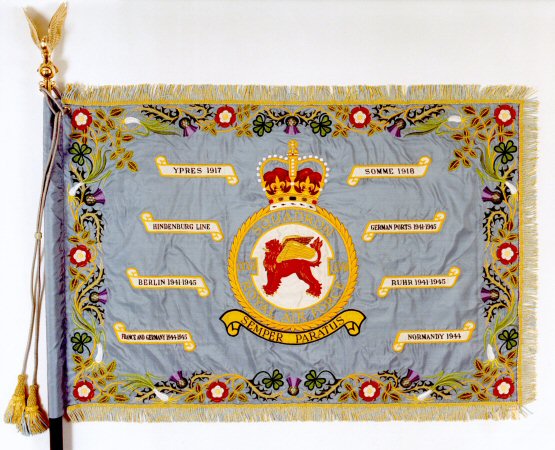 ©Crown
Copyright
©Crown
Copyright
The criteria for the award of a Standard was either that it had completed 25 years of service in the RAF, AuxAF, RFC or RNAS or had earned the King's appreciation of 'outstanding operations'. So far only Nos 617 and 120 Squadrons have qualified under the latter criteria. Due to the early post-war austerity, despite 30 squadrons qualifying immediately in 1943, the first standards were not produced and presented until the 1950s, details of individual squadron standards can be found in the Squadron history section.
Squadrons can be presented with a new Standard and when this happens the old Standard is laid up in suitable location such as the Rotunda in the College Hall Officers Mess at Cranwell or a Church/Cathedral associated with the squadron. Similarly the Standard of a disbanding unit will also be laid up in a suitable location, but could be returned to the unit should it reform at a later date.
At the same time as he announced the awards of Squadron Standards, King George VI also announced his intention to present a Colour to the RAF and other higher formations such Commands and Colleges. Colours presented over the years are: -
The Kings/Queens Colour for the RAF College, Cranwell (approved 27 December 1947, presented 6 July 1948)
The Kings/Queens Colour for the RAF in the UK (approved 27 December 1947, presented, 16 May 1951)
The Queens Colour for No 1 School of Technical Training (approved 27 December 1947, presented 25 July 1952)
The Queens Colour for the RAF Regiment (presented 17 March 1953)
The Queens Colour for the Near East Air Force (presented 14 October 1960, laid up 31 May 1976)
The Queens Colour for the Far East Air Force (presented 13 July 1961, laid up 30 January 1972)
The Queens Colour for the Central Flying School (presented 26 June 1969)
The Queens Colour for RAF Germany (presented 16 September 1970, laid up 27 June 1993)
The Queens Colour for the Royal Auxiliary Air Force (presented 12 June 1989)
The Queens Colour for RAF Halton (presented 31 October 1997)
World War 1
| Battle Honour | Condition |
| Home Waters Operations 1914-1918 | Operations over home waters, whether by land-based or carrier-borne aircraft. |
| Home Defence 1916-1918 | Interception operations against enemy aircraft and Zeppelins raiding Great Britain. |
|
Western Front 1914-1918 NB Many squadrons seem to split this Honour into individual named battles (see photo above) |
Operations in support of Allied armies in Belgium and France. |
| Independent Force and Germany 1914-1918 |
Squadrons based in France as part of the Independent Force; and for operations over Germany, whether by squadrons based in France (as part of the Independent Force or not) or by carrier-borne aircraft. |
| Italian Front and Adriatic 1917-1918 | Operations over the Trentino and neighbouring areas, in support of the Allied armies on the ltalian front; and for operations over the Adriatic and attacks on targets on the Dalmatian coast. |
| Aegean 1915-1918 | Operations in the Aegean area against the German/Turkish land, sea and air forces, including the attempt to force the Dardenelles, the Gallipoli campaign, and the various operations over the Aegean Sea and against Turkish coastal targets. |
| Macedonia 1916-1918 | Operations in support of the Allied Forces at Salonika and in their eventual advance and defeat of the Bulgarian armies in Macedonia and adjoining territories. |
| Mesopotamia 1915-1918 | Operations over Mesopotamia and Persia in the liberation of Mesopotamia from the Turks. |
| Palestine 1916-1918 | Operations over Palestine, Transjordan and Syria, in the liberation of those territories from the Turks. |
| Arabia 1916-1917 | Operations over Arabia, in support of the Arab Revolt against the Turks. |
| Egypt 1914-1917 | Operations by squadrons based in Egypt during the Turkish advance on the Suez Canal across Sinai; and for operations in the Western Desert against the Senussi. |
| All the above can be placed on a Standard but those below are not to be placed on the Standard: | |
|
East Africa 1915-1917 |
Operations over German East Africa during its conquest from the enemy, whether by aircraft based in the country or operating from exterior seaplane bases. |
|
South-West Africa 1915 |
Operations by South African Personnel during the conquest of German South-West Africa. |
Inter-war Period
Campaigns in various parts of the Empire, particularly India and Iraq during the Inter-war period entitled squadrons to a number of possible battle honours but these were not to placed on the standard and specific conditions were not issued, the decision as to whether a unit was entitled was determined by an Air Council Committee after scrutinising the unit's records
|
South Persia 1918-1919 |
Waziristan 1919-1920 |
Mohmand 1927 |
Northern Kurdistan 1932 |
|
North Russia 1918-1919 |
North-West Persia 1920 |
Aden 1928 |
Mohmand 1933 |
|
Kurdistan 1919 |
Somaliland 1920 |
Iraq 1928-1929 |
Aden 1934 |
|
South Russia 1919-1920 |
Sudan 1920 |
Aden 1929 |
North-West Frontier 1935-1939 |
|
Iraq 1919-1920 |
Kurdistan 1922-1924 |
North-West Frontier 1930-1931 |
Palestine 1936-1939 |
|
Afghanistan 1919-1920 |
Iraq 1923-1925 |
Kurdistan 1930-1931 |
|
|
Mahsud 1919-1920 |
Transjordan 1924 |
Burma 1930-1932 |
|
Second World War
| Battle Honour | Condition |
|
Battle of Britain |
Interception operations by fighter squadrons 1940 in the Battle of Britain (August to October 1940). |
|
Home Defence 1940-1945 |
Interception operations after the Battle of Britain, in defence of Great Britain and Northern Ireland against enemy aircraft and flying bombs. |
|
Invasion Ports 1940 |
Bombing operations against German occupied Channel ports, to dislocate enemy preparations for the invasion of England. |
|
France and Low Countries1939-1940 |
Operations in France and the Low Countries between the outbreak of war and the Fall of France (3rd September 1939 to 25th June 1940). Applicable both to squadrons based in France (the Air Component and the Advanced Air Striking Force) and to squadrons operating from home bases. |
|
Dunkirk |
Operations covering the evacuation of the British Expeditionary Force and the French from Dunkirk 26th May to 4th June 1940. |
|
Meuse Bridges |
Squadrons which participated in bombing against the crossings of the Meuse during the German breakthrough between Sedan and Dinant (12th to 14th May 1940.) |
|
Atlantic 1939-1945 |
Operations by aircraft of Coastal Command and others employed in the coastal role over the Atlantic Ocean from the outbreak of war to VE Day. |
|
Bismarck |
Operations by aircraft of Coastal Command associated with the action against the Bismarck (24th to 29th May 1941). |
|
Channel and North Sea 1939-1945 |
Ship attack, anti-submarine, and mining operations over the English Channel and North Sea from the outbreak of war to VE Day. |
|
Tirpitz |
Operations resulting in the sinking of the Tirpitz. |
|
Norway 1940 |
Operations over Norway during the German invasion (9th April to 9th June 1940): applicable both to squadrons based in Norway and to those operating from home bases. |
|
Baltic 1939-1945 |
Operations over the Baltic and its approach by squadrons of Bomber and Coastal Commands from the outbreak of war to VE Day. |
|
Fortress Europe 1940-44 |
Operations by aircraft based in the British Isles against targets in Germany, Italy and enemy-occupied Europe, from the Fall of France to the invasion of Normandy. |
|
The Dams |
Squadrons participating in the operations for breaching the Moehne, Eider, Sorpe and Kembs Dams (May 1943 to October 1944) |
|
Dieppe |
Squadrons which participated in the combined operations against Dieppe on 19th August 1942. |
|
France and Germany1944-45 |
Operations over France, Belgium, Holland and Germany during the liberation of North-West Europe and the advance into the enemy's homeland, from the initiation of air action preparatory to the invasion of France to VE Day (April 1944 to 8th May 1945) |
|
Biscay Ports 1940-45 |
Operations over the Bay of Biscay ports from the Fall of France to VE Day. |
|
Ruhr 1940-1945 |
Bombardment of the Ruhr by aircraft of Bomber Command. |
|
Berlin 1940-45 |
Bombardment of Berlin by aircraft of Bomber Command. |
|
German Ports 1940-1945 |
Bombardment of the German ports by aircraft of Bomber and Coastal Commands. |
|
Normandy 1944 |
Operations supporting the Allied landings in Normandy the establishment of the lodgement area, and the subsequent breakthrough (June to August 1944). |
|
Arnhem |
Squadrons participating in the operations of the Allied Airborne Army (17th to 26th September 1944). |
|
Walcheren |
Operations in support of the capture of the Island of Walcheren (3rd October to 9th November 1944). |
|
Rhine |
Operations in support of the battle for the Rhine crossing (8th February to 24th March 1945) |
|
Biscay 1940-1945 |
Operations over the Bay of Biscay by aircraft of Coastal Command and Fighter Command, and Bomber Command aircraft loaned to Coastal Command, between the fall of France and VE Day (25th June 1940 to 8th May 1945). |
|
East Africa 1940-1941 |
Operations over Kenya, the Sudan, Abyssinia, Italian Somaliland, British Somaliland, Eritrea, and the Red Sea, during the campaign which resulted in the conquest of Italian East Africa (10th June 1940 to 27th November 1941). |
|
Greece 1940-1941 |
Operations over Albania and Greece during the Italian and German invasion, whether carried out by squadrons based in Greece or operating from external bases (28th October 1940 to 30th April 1941). |
|
South-East Europe 1942-1945 |
Operations over Yugoslavia, Hungary, Romania, Bulgaria and Greece. |
|
Egypt and Libya 1940-1943 |
Operations in the defence of Egypt and the conquest of Libya, from the outbreak of war against Italy to the retreat of the Axis forces into Tunisia (10th June 1940 to 6th February 1943). |
|
El Alamein |
Operations during the retreat to El Alamein and subsequent actions (June to November 1942). |
|
El Hamma |
Operations at El Hamma in support of the Battle of the Mareth Line by squadrons operationally controlled by Air Headquarters Western Desert (including No 205 Group squadrons engaged in tactical bombing ), during the period 20/21st March to 28th March1943.) |
|
Malta 1940-1942 |
Squadrons participating in defensive, offensive, and reconnaissance operations from Malta during the period of enemy action against the island (10th June 1940 to 31st December 1942). |
|
North Africa 1942-1943 |
Operations in connection with the campaign in French North Africa, from the initial landings in Algeria to the expulsion of the Axis Powers from Tunisia (8th November 1942 to 13th may 1943). |
|
Mediterranean 1940-43 |
Operations over Italy, Sicily and the Mediterranean and Aegean Seas by aircraft based in the Mediterranean area (including reconnaissance, convoy protection, mining, and attacks on enemy ports and shipping) between the entry of Italy into the war and the initiation of air action preparatory to the Sicilian campaign (10th June 1940 to 30th June 1943). |
|
Sicily 1943 |
Operations in furtherance of the conquest of Sicily (1st July to 17th August 1943) by aircraft based in Africa, Malta and Sicily. |
|
Italy 1943-1945 |
Operations over Italy |
|
Salerno |
Operations in support of the Allied landings in Italy (9th to 16th September 1943). |
|
Anzio and Nettuno |
Operations in support of the Allied landings at Anzio and Nettuno (January 1944) |
|
Gustav Line |
Squadrons participating in the operations against the Gustav Line (May 1944). |
|
Gothic Line |
Air Operations in support of the breaching of the Gothic Line (August to September 1944). |
|
Pacific 1941-1945 |
Operations against the Japanese in the Pacific theatre, throughout the war with Japan (8th December 1941 to 15th August 1945). |
|
Malaya1941-1942 |
Operations against the Japanese in Malaya, Sumatra and Java, from 8th December 1941, until the final capitulation in Java on 12th March 1942. |
|
Ceylon April 1942 |
Operations against Japanese aircraft and naval units by squadrons based in Ceylon during the Japanese attacks of April 1942 |
|
Eastern Waters 1941-1945 |
Operations over waters east of the Mediterranean and Red Sea, including the Indian Ocean, the Bay of Bengal the Java Sea, and the South China Sea, throughout the war with Japan. |
|
Burma 1941-1942 |
Operations in defence of Rangoon and in support of British Forces during the Japanese invasion of Burma (December 1941 to May 1942). |
|
Burma 1944-1945 |
Operations during the 14th Army's advance from Imphal to Rangoon, the coastal amphibious assaults, and the Battle of Pegu Yomas (August 1944 to August 1945). |
|
Special Operations |
Operations by squadrons regularly assigned to special duties, i.e the succour of resistance movements in enemy-occupied countries by dropping supplies and by introducing and evacuating personnel by air, from the formation of the first special duty flight (20th August 1940) after the Fall of France to VE and VJ Days. |
|
Arctic 1940-1945 |
Operations over the Arctic by squadrons of Coastal Command based in Iceland, Russia and the Shetlands. |
|
Arakan 1942-1944 |
Operations by fighter, bomber and transport squadrons in support of the first and second Arakan campaigns (November 1942 to February 1943, and November 1943 to March 1944). |
|
Iraq 1941 |
Operations in the defeat of Rashid Ali's rebellion (2nd to 31st May 1941). |
|
Habbaniya |
Units engaged in the defence of Habbaniya (30th April to 6th May 1941). |
|
Russia 1941-1945 |
Operations from Russian bases. |
|
Syria 1941 |
Operations over Syria during the campaign against the Vichy French (8th June to 12th July 1941). |
|
North Burma 1943-1944 |
The supply by air of General Wingate 's first long-range penetration into North Burma (February to June 1943) and for the air supply and support of his second expedition (5th March to 26th June 1944). |
|
Manipur 1944 |
Operations in support of the besieged forces at Imphal (March to July 1944). |
|
Madagascar 1942 |
Operations by squadrons of SAAF during and after the landings in Madagascar. |
Post World War Two
Since World War Two only three Theatre Honours have been awarded to unit of the RAF, these being 'South Atlantic 1982', 'Iraq 1991' and 'Iraq 2003'
| Battle Honour | Condition |
|
South Atlantic 1982
|
Awarded to Squadrons of the Royal Air Force, which saw service between 2 April and 14 June 1982 south of 35o south and north of 60o south or took part in an operational sortie south of Ascension Island. It was awarded to: - No 1(F) Squadron No 18 Squadron No 42 Squadron No 44 Squadron No 47 Squadron No 50 Squadron No 51 Squadron No 55 Squadron No 57 Squadron No 63 Squadron RAF Regiment No 70 Squadron No 101 Squadron No 120 Squadron No 201 Squadron No 206 Squadron The only two flying units permitted to display it on their standards are No 1 and No 18 Squadrons. |
| Iraq 1991 |
Awarded to Squadrons which were involved in direct confrontation with the enemy and had demonstrated gallantry and spirit under fire With the right to emblazon the honour on squadron Standards: No 1 Squadron RAF Regiment No 2 Squadron No 6 Squadron No 7 Squadron No 9 Squadron No 12 Squadron No 13 Squadron No 14 Squadron No 15 Squadron No 16 Squadron No 17 Squadron No 18 Squadron No 20 Squadron No 27 Squadron No 31 Squadron No 33 Squadron No 41 Squadron No 54 Squadron No 208 Squadron No 230 Squadron No 617 Squadron Without the right to emblazon the honour on squadron Standards: No 10 Squadron No 20 Squadron RAF Regiment No 24 Squadron No 26 Squadron RAF Regiment No 29 Squadron No 30 Squadron No 32 Squadron No 34 Squadron RAF Regiment No 42 Squadron No 43 Squadron No 47 Squadron No 51 Squadron No 51 Squadron RAF Regiment No 55 Squadron No 58 Squadron RAF Regiment No 66 Squadron RAF Regiment No 70 Squadron No 101 Squadron No 120 Squadron No 201 Squadron No 206 Squadron No 216 Squadron |
| Iraq 2003 |
This was awarded for participation in operations in the Iraq campaign in 2003 as was awarded to the following units: - With the right to emblazon the honour on squadron Standards: No 1 (Fighter) Squadron RAF No 11 (Army Co-operation) Squadron RAF No 3 Squadron RAF No IV (Army Co-operation) Squadron RAF No 7 Squadron RAF Promotion No IX (Bomber) Squadron RAF No 12 (Bomber) Squadron RAF No 31 Squadron No 47 Squadron RAF No 617 Squadron RAF No 51 Squadron RAF Regiment Without the right to emblazon the honour on squadron Standards: No 8 Squadron RAF No 10 Squadron RAF No 18 (Bomber) Squadron RAF No 23 Squadron RAF No 33 Squadron RAF No 39 Squadron RAF No 43 (Fighter) Squadron RAF No 51 Squadron RAF No 101 Squadron RAF No 111 (Fighter) Squadron RAF No 120 Squadron RAF No 201 Squadron RAF No 206 Squadron RAF No 216 Squadron RAF No 1 Squadron RAF Regiment No 11 Squadron RAF Regiment No 27 Squadron RAF Regiment No 16 Squadron RAF Regiment No 34 Squadron RAF Regiment |
Colours
Some units of the RAF have been awarded their own Coats of Arms or Armorial Bearings, which can be found in the appropriate unit history section, these include: -
Royal Air Force College, Cranwell
Central Flying School
Royal Air Force Flying College
Royal Aircraft Establishment
Empire Test Pilots School
Aeroplane and Armament Experimental Establishment
RAF Ensign
The idea of an RAF Ensign was first put forward in 1918 but it faced opposition from the Royal Navy, who had the power of veto over any flag to be flown in the British Empire. After rejecting a number of designs, the Admiralty eventually accepted the current design in December 1920 and on 24 March 1921, King George V signed an Order in Council (AMWO 273/1921) ratifying its use.
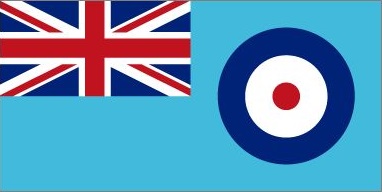
Pennants and Star Plates (courtesy Wg Cdr C G Jefford)
Pennants, to be flown by Officers Commanding RAF units, were first introduced in 1918 for the ranks of major to major-general (squadron leader to air vice-marshal from 1919) (AMWO 782/1918). The introduction of the RAF Ensign was announced in 1920, (AMWO 1130/1920) the detail of its design being formally authorised by an Order in Council of 24 March 1921. This meant that all RAF stations would now have to be provided with a mast and gaff. Once these had been erected the Ensign was to be flown from the peak (of the gaff), with the COís rank pennant at the masthead. The range of pennant designs was extended in 1927 (AMWO 8/1927) to embrace air marshal to marshal of the RAF. In 1938, (AMO A284/1938) miniature versions were introduced, to be flown as flags from a mast on the off-side front wing of the staff cars of Air Officers Commanding.
During WW II, there were some amendments to the detail as to who could, and who could not, fly rank flags on their cars, notably in May 1941 (AMO A397/1941) when they were restricted to the CAS and Air Officers Commanding commands and groups at all times, and (but only when visiting RAF units) members of the Air Council and Inspectors General. These rank flags were now to be flown from the near-side front wing with the exception of CASís which was to be flown centrally on the radiator.
The next significant change occurred in 1945 (AMO A640/1945) when the rules were revised and restated to include the introduction of a unique personal flag, featuring the RAF badge on a light blue background, which was to be flown at all times, by the car of the Secretary of State for Air. At the same time the CAS and certain AOCinCs abroad were authorised to fly a miniature RAF Ensign; the cars of all other air and senior officers in command, including Commandants of nominated Colleges and Schools, and Station Commanders not below the rank of wing commander, continued to fly miniature rank flags, although, depending upon circumstances, these were often restricted to within the bounds of the unit under command. In all cases these 12″ ◊ 4Ĺ″ flags were now to be mounted centrally on the radiator. In June 1947 (AMO A518/1947) there were further minor amendments to the list of those authorised to fly miniature rank flags on their cars while the dimensions of (only) the miniature RAF Ensign were changed to 12″ ◊ 6″. All of these changes had been confined to the use of miniature flags on motor cars, all squadron leaders and above commanding RAF units continued to fly their full-sized rank pennants as they had done since 1918, and as they still do.
In March 1948, the Air Council Standing Committee decided to extend the range of unique SoS/CAS-style flags associated with specific senior appointments and to replace the miniature rank flags on cars with star plates. [ACSC Conclusions 3(48)] However, it was January 1951 before the use of star plates was authorised (AMO A763/1950) and, allowing for the time required for manufacture, it would have been some months before they actually became available. They featured, on a pale blue ground, a single silver star for an air commodore, increasing to five for a marshal of the RAF. Star plates were/are only to be displayed when the officer was/is on board, otherwise, as had always been the case with flags, they are masked with a canvas cover (during an AOCís Inspection, the host of this website actually witnessed one AVM riding around RAF Shawbury on a bicycle fitted with a star plate). The design of the four new distinguishing flags, to be flown by Members of the Air Council, AOCinCs, AOCs and certain other specific appointments, including Station Commanders ranked as wing commanders or above, were not announced until as late as November 1951 (AMO A680/1951) and they did not materialise until 1952. All of the new car flags were to be 9″ ◊ 4Ĺ″ with the exception of SoSís which was now to be 12″ ◊ 6″ to match the RAF Ensign which was now flown only by CAS.
| Rank | Pennant | Star Plate |
| Squadron Leader (in command) |
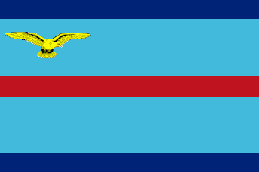 |
No Star Plate |
| Wing Commander |
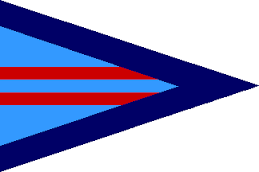 |
No Star Plate |
| Group Captain |
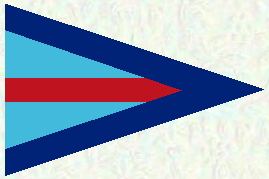 |
No Star Plate |
| Air Commodore |
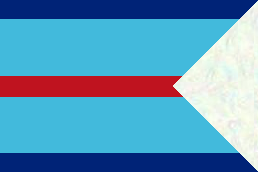 |
 |
| Air Vice Marshal |
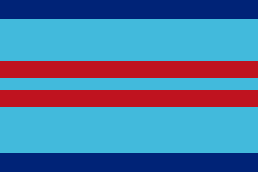 |
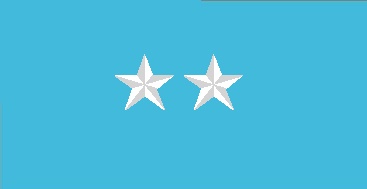 |
| Air Marshal |
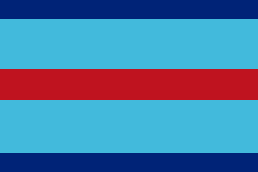 |
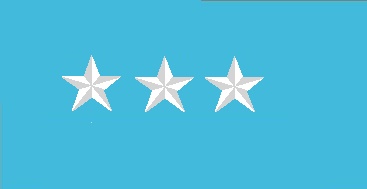 |
| Air Chief Marshal |
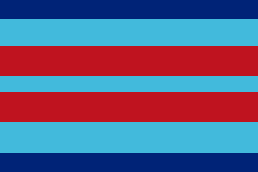 |
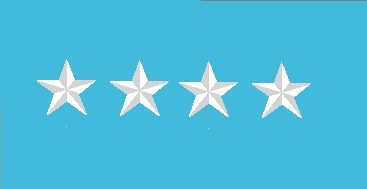 |
| Marshal of the RAF |
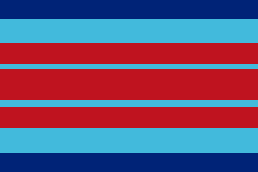 |
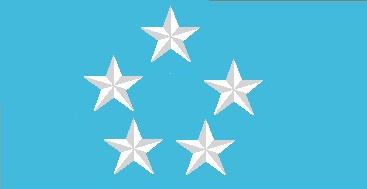 |
Car Flags
As well as carrying Star Plate denoting the rank, a staff car may also carry a flag on a mast located centrally on the radiator to identify the appointment of the officer, as shown below: -
| Chief of the Air Staff and AOC-in-Cs Abroad |
 |
| Member of the Air Council and Inspector-General of the RAF |
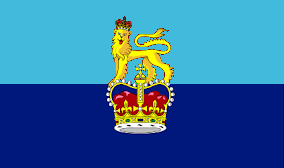 |
| AOC-in-Cs of Home Commands |
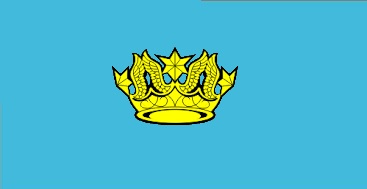 |
| AOC Group HQs |
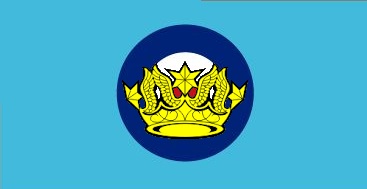 |
| Sector/Station Commander (Wg Cdr and above)* |
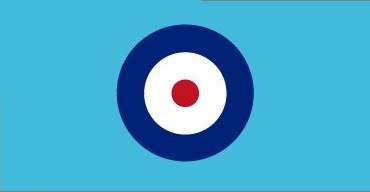 |
*This is the only flag flown by officers below Air Rank.
New designs for emblazoning drums of RAF bands have been introduced. Drawings of the new designs are annexed. The first design is intended for use on drums, bass, and the second for use on drums side (Stores Ref 19/2). The name of the band is to be inserted in that part of the scroll whore the word "Central "appears in the reproductions.
New designs have also been introduced for the drum panel and for the hoops, cord, bottom and top of drums, side (Stores Ref l9/2)
The emblazoning with the new design of all drums provided out of public funds will be carried out, for units at home, at No I Stares Depot, and for units abroad at the appropriate depot or stores distributing unit. Units are to demand drums within the establishment laid down in Scale Z I of AP 830, Vol III, with the new design to replace the drums at present on charge, and on their receipt are to return the drums with the obsolete design to the appropriate depot or stores distributing unit. Demands will be dealt with at the depot in the order in which they are received.
Two drums emblazoned with the new designs and with panels and hoops painted in the approved manner will be supplied to each depot at Stores distributing unit abroad from No 1 Stores Depot for guidance in the re-emblazoning and repainting of drums returned from local units. The necessary transfers of the new designs, supplies of special enamels, red, royal blue and blue-grey, and drum fittings and embellishments, as detailed, are to be demanded from No 1 Stores Depot in the usual manner.
ACCESSORIES FOR DRUMS, SIDE (Stores Ref 19/2).
Braces and cords, at present provided in buff and white respectively, are replaced by braces, blue (Stores Ref 19/27), and cords, blue (Stores Ref 19/26). Carriages, leather, buff, are replaced by carriages, leather, black (Stores Ref. 19/28). The buff braces, white cords and buff carriages are to be returned to the appropriate stores depot for disposal out of the Service to the best advantage, in accordance with current recognised procedure.
Aprons, leg, leather (black) (Stores Ref. 19/25) will be
issued on demand at the rate of one for each drum, side (Stores Ref
19/2) held in accordance with Scale No Z I of AP 830, Vol 111.
DRUMS PROVIDED FROM NON-PUBLIC FUNDS
With a view to securing uniformity in the decoration and embellishment of drums throughout the Royal Air Force, it has been decided that instruments purchased out of voluntary band funds may, if desired, be emblazoned and painted with the new designs and fitted with braces, etc., in the new colours, at RAF depots as a repayment service, the costs being borne by the above-mentioned funds. An estimate of the cost of re-emblazoning and refitting of drums may, if desired, be obtained by units from the CO, No 1 Stores Depot, prior to the submission of demands. Separate demands for the emblazoning and fitting of non-public drums under the provisions of this paragraph are to be submitted by units desiring this service to the appropriate stores depot or stores distributing unit. To ensure that drums are returned to the unit from which they emanated, non-public drums are to be labelled with the name of the unit, and the number of the relevant demand is to be shown on the label. The emblazoning of non-public drums will be undertaken only when all requirements for service drums have been met.
Aprons, leg, leather (black) (Stores Ref 19/25) and carriages, black (Stores Ref. 19/28), for use with non-public drums, may be obtained, if required, on repayments from RAF sources.
|
|
|
|
Source - Air Ministry Order A128/1932 dated 5 May 1932.
Flying of Dominion and Foreign Ensigns
At RAF stations where complete units of dominion or foreign air forces are located, the RAF ensign will be flown at the station headquarters. The ensigns of the dominion or foreign forces may be flown at their unit headquarters.
At stations in the United Kingdom not controlled by the Royal Air Force where complete units of dominion or foreign air forces are located, the ensign of the dominion air force controlling the station will be flown at the station headquarters. The ensigns of other dominion or foreign forces located, at that station may be flown at their unit headquarters.
(AMO A258/40 cancelled.)
Source - Air Ministry Order A752/1940 dated 10 October 1940.
[Badges | Standards | Battle Honours | Other Heraldry | Drum Markings]
Crown Copyright material is reproduced by permission of the Directorate of Intellectual Property Rights
This entry was last updated on 09/01/26